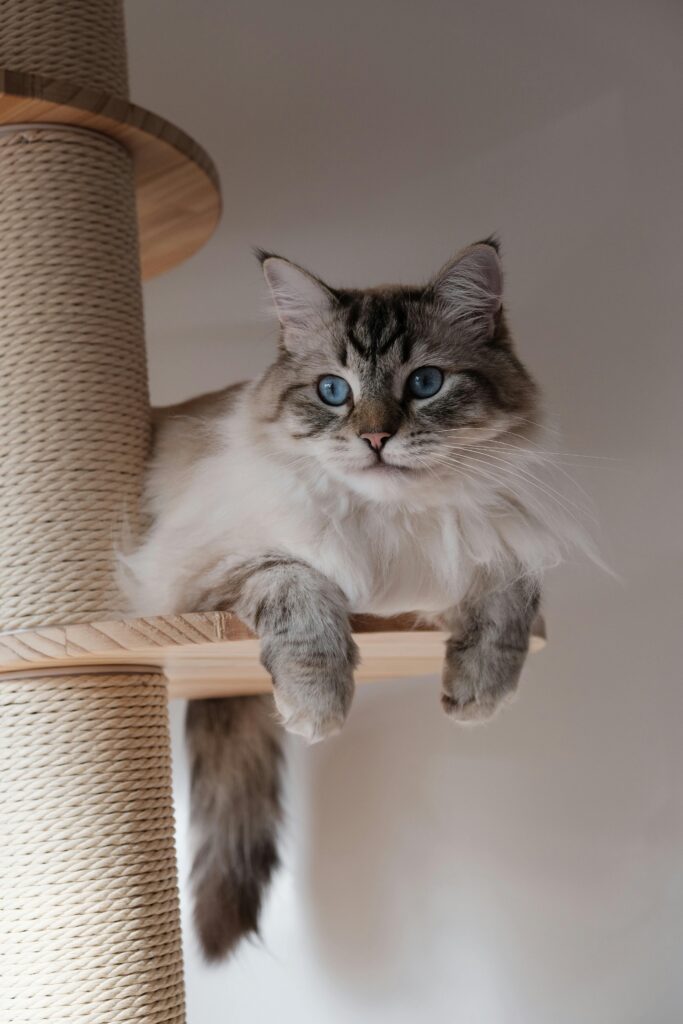
Lynx Ragdoll Cats: The Complete Guide to Seal, Blue, and Bicolor Lynx Patterns
If you’ve ever seen a Ragdoll with soft tabby stripes across its face and legs, you were likely looking at a Lynx Ragdoll cat. This beautiful variation blends the elegance of the traditional Ragdoll with the distinctive striping of the tabby gene. Lynx Ragdoll cats come in several color patterns including seal lynx, blue lynx, and bicolor lynx, each with its own charm and subtle differences.
Whether you are researching before adopting a kitten or simply love learning about color genetics, this guide covers everything you need to know about the Lynx Point Ragdoll cat.
What Is a Lynx Ragdoll Cat?
A Lynx Ragdoll is a Ragdoll that carries the agouti or “tabby” gene, which causes faint stripes or bars on the face, legs, and tail. Instead of solid points like traditional Ragdolls, the lynx pattern gives a more textured, wild appearance.
The lynx gene does not change the base color (seal, blue, chocolate, lilac, etc.). It simply adds a layer of pattern on top of the existing point color. For example:
- A Seal Lynx Ragdoll has warm brown striping.
- A Blue Lynx Ragdoll has soft gray striping.
- A Bicolor Lynx Ragdoll combines tabby stripes with white facial and body markings.
You can learn more about the full range of Ragdoll colors in the Complete Guide to Ragdoll Cats.
Lynx Ragdoll Cat Appearance
Lynx Ragdolls are instantly recognizable for their signature “M” marking on the forehead, faint bars on the legs, and a lined nose that gives the appearance of eyeliner. Their coats are medium to long, plush, and incredibly soft to the touch.
Eye color is always blue, ranging from pale sky to deep sapphire, and the paw pads and nose leather vary depending on the base color.
Typical features include:
- Distinct tabby pattern around the eyes and cheeks
- Contrasting stripes on the tail and legs
- Lighter body color with pointed ears and mask
- Gentle, sweet expression
Seal Lynx Ragdoll Cats
The Seal Lynx Ragdoll is one of the most popular variations. The base color is deep brown, and the lynx pattern adds lighter beige or cream striping. Their tails often have strong ring markings, and their faces show beautiful contrast between dark seal tones and pale highlights.
These cats have a warm, traditional look that feels classic to the breed.
If you love the cozy richness of brown coats, read our full post about Seal Lynx Ragdoll Cats to see photos and care tips.
Blue Lynx Ragdoll Cats
The Blue Lynx Ragdoll has cooler tones with soft silver-gray points and pale bluish stripes. Their coat color lightens as they mature, often giving a misty, cloudlike appearance.
They are known for calm, affectionate personalities and tend to be slightly lighter in coat density than their seal counterparts.
See more photos and details in our Blue Lynx Ragdoll Cat Guide.
Bicolor Lynx Ragdoll Cats
The Bicolor Lynx Ragdoll adds white markings over the lynx pattern. This can appear as a white inverted “V” on the face, white legs, and a lighter belly.
Because bicolors already have strong contrast, the tabby striping often looks delicate, creating an almost watercolor effect.
This combination is striking in photos and one of the rarest color varieties to find. If you are looking for something truly eye-catching, explore our feature on the Blue Lynx Point Ragdoll.
Understanding DNA Testing and Genetics Behind Lynx Point Cats
The Lynx Point cat is one of the most fascinating examples of feline color genetics in action. Often described as a “tabby with Siamese colors,” the lynx point pattern combines the striped tabby gene with the colorpoint gene, resulting in a beautiful coat that darkens only on the cooler parts of the body — the face, ears, legs, and tail. This pattern is common in breeds such as the Ragdoll, Balinese, and Siamese, and it can also appear in mixed-breed cats that happen to inherit the same genetic traits.
Below, we’ll break down what DNA testing can tell you about your Lynx Point cat, how colorpoint genetics work, why kittens are born white, and how traits like blue eyes and even nystagmus (eye movement) are connected to these genes.
The tabby DNA combined with colorpoint is why people often ask if Ragdoll Cats can be Tabby?
What Makes a Lynx Point Cat?
A Lynx Point cat is, genetically speaking, a tabby with colorpoint genes. The tabby pattern gives the cat its stripes and that signature “M” shape on the forehead, while the colorpoint gene modifies pigment production based on temperature. Read more about the Tabby Gene here.
This combination produces a cat that has:
- Stripes on the face, legs, and tail
- Pale cream or white body color
- Blue eyes due to lack of pigment in the iris
- Darker points where the body temperature is cooler
If you’ve ever noticed that your cat’s fur changes shade as they age, that’s the colorpoint gene at work. Young kittens are born pure white because the warmth of their mother’s womb prevents pigment formation. As they grow and their extremities cool, color begins to appear gradually. This process can continue for years, which is why older colorpoint cats often appear darker than they were as kittens.
The Science Behind the Colorpoint Gene
The colorpoint gene is a temperature-sensitive form of partial albinism. It affects how the body produces melanin — the pigment responsible for color.
The warmer the skin, the less pigment the hair follicle produces. This means that fur growing in cooler body regions becomes darker.
For example:
- The face, ears, legs, and tail are cooler, so they darken.
- The torso and belly are warmer, so they stay lighter.
In cats like Ragdolls or Siamese, this gene is located on the C locus, which controls albinism variants. There are several different alleles at this locus:
- C – full color (no albinism)
- cb – Burmese (dark colorpoint, warmer tones)
- cs – Siamese (cooler colorpoint, lighter tones)
- ca – albino (no pigment at all)
To produce a colorpoint cat, both parents must pass down one of these recessive alleles. A Lynx Point, therefore, inherits two colorpoint alleles (usually Siamese-type, cs/cs) plus the tabby pattern gene. The result is a striped colorpoint cat with blue eyes and that iconic “frosted” coat look.
Lynx Point vs. Traditional Point
It’s easy to confuse a Lynx Point with a standard Seal Point or Blue Point, but genetically they are quite different. A Seal Point has solid dark points with no tabby pattern. A Lynx Point, on the other hand, carries the agouti (tabby) gene, which adds those fine stripes and banding across each hair shaft.
That’s why if you look closely at a Lynx Point’s coat, you might notice each strand has two or three color bands, similar to what the Reddit poster described — darker at the tip, lighter in the middle, and sometimes a second darker ring toward the base. This banding gives the coat a textured look and can even make it feel slightly coarser compared to solid-point cats.
How to DNA Test for Lynx Point Cats
If you’re curious about your cat’s ancestry or want to confirm whether they truly carry the colorpoint or tabby genes, DNA testing is the most accurate way to find out.
Labs such as UC Davis Veterinary Genetics Laboratory, Basepaws, and Optimal Selection offer comprehensive feline DNA panels that include color, coat pattern, and ancestry traits.
Through DNA testing, you can identify:
- Which colorpoint alleles your cat carries (Siamese, Burmese, or Tonkinese)
- Whether they are homozygous (two copies) or heterozygous (one copy) for colorpoint
- The presence of the agouti gene responsible for tabby striping
- Genes for white spotting, dilute colors, and long hair
- Health markers and potential carrier status for hereditary conditions
This testing can clarify whether your cat’s coloring is due to a true lynx point genotype or if they simply have partial resemblance through dilution, temperature sensitivity, or other modifiers.
If your cat’s appearance includes white paws or patches, that’s an additional gene called white spotting — a dominant trait often inherited from one parent. For instance, in the Reddit example, the cat’s mother was a piebald tabby, so the white spotting gene likely came from her.
Blue Eyes and Temperature-Sensitive Albinism
One of the most recognizable traits of the Lynx Point Ragdoll and other colorpoint breeds is their striking blue eyes. The reason behind this is again tied to temperature-sensitive albinism.
The same lack of melanin that keeps their body pale also affects their irises. Without pigment, light scatters within the eye, which makes them appear blue — similar to the way the sky looks blue.
However, this gene can also cause nystagmus, a subtle eye movement some colorpoint cats experience, especially when stressed. It’s harmless in most cases and often seen in cats with strong Siamese ancestry. The condition happens because the optic nerves are slightly crossed during development, an effect of the colorpoint gene itself rather than a health defect.
Leucism vs. Albinism in Cats
Many cat owners wonder whether their white or cream cat is albino or leucistic. These terms are often used interchangeably in wildlife biology, but in domestic cat genetics, the distinctions are specific.
- Albinism refers to cats with the ca allele on the C locus, which completely blocks pigment production. These cats have pinkish skin, red or very pale blue eyes, and light sensitivity.
- Leucism is a broader term used in wild species to describe animals that are “more white than normal” but still produce some pigment. In cats, it’s not a defined genetic term. Instead, traits like dominant white or white spotting cover what many call leucism.
So while colorpoint cats are sometimes described as “temperature-sensitive albinos,” they are not albino in the pure sense. Their color production is modified, not absent.
How Environment Affects Lynx Point Coloring
Because colorpoint expression depends on temperature, environmental factors influence how dark or light your cat becomes. Cats living in cooler climates often develop deeper, richer color on their points, while those in warm homes may stay paler.
You might also notice seasonal color shifts:
- In winter, the coat darkens as the body cools.
- In summer, it lightens due to warmth.
This temperature sensitivity is the reason Ragdolls, Birmans, and other colorpoint breeds can look dramatically different from photos taken just a few months apart.
Can You Tell the Type of Colorpoint Without a DNA Test?
Visually, you can make an educated guess, but only genetic testing can confirm which alleles your cat carries.
The Siamese allele (cs) produces the lightest, most defined contrast — typical of Ragdolls and Siamese.
The Burmese allele (cb) results in darker, warmer shading.
A combination of both (cb/cs) creates the Tonkinese look — intermediate in tone.
If your cat has vivid blue eyes and strong contrast between the body and points, it’s most likely the Siamese allele pair (cs/cs).
For breeders and pet owners who want accuracy, testing through UC Davis or another reputable laboratory can identify these alleles and verify your cat’s genetic color type.
Cat Colorpoint Origins
All colorpoint cats trace their ancestry back to Southeast Asia, particularly Thailand, where the Siamese breed originated. The gene spread through selective breeding and naturally occurring mutations that gave rise to several modern breeds — including the Ragdoll, Birman, Balinese, and Tonkinese.
Because colorpoint is recessive, even cats from mixed backgrounds can produce colorpoint kittens if both parents carry the gene. That’s why feral or domestic shorthaired cats sometimes surprise their owners by producing white kittens that darken into lynx points as they grow.
Lynx Ragdoll Gene Summary
The Lynx Point Ragdoll and other colorpoint-tabby cats are living demonstrations of how temperature, recessive genetics, and selective breeding intersect. From the shimmering striped coat to the glowing blue eyes, every detail tells a story written in DNA.
If you want to learn more about your cat’s lineage, appearance, and genetic makeup, consider a DNA test from a reputable veterinary lab. It’s a rewarding way to understand not only your cat’s unique look but also their health background and ancestry.
Read more on our related pages:
- Ragdoll Cat Colors and Genetics
- Blue Lynx Ragdoll Cat Guide
- Complete Guide to Ragdoll Cats
- Ragdoll Kittens for Sale
Lynx Ragdoll Temperament
Like all Ragdolls, lynx varieties are calm, loving, and deeply bonded to their families. They follow you from room to room, enjoy gentle play, and often flop in your arms like a plush toy.
Many owners describe Lynx Ragdolls as slightly more curious and alert compared to solid-point Ragdolls, likely because of the tabby gene’s association with playful behavior.
These cats thrive in homes where they get plenty of affection and gentle interaction.
Grooming and Care
Despite their long fur, Lynx Ragdolls are relatively low-maintenance. Their coat rarely mats if brushed weekly with a stainless steel comb. Bathing is only needed occasionally.
Key care tips:
- Comb once or twice per week
- Wipe eyes gently with a soft cloth if tearing occurs
- Feed a high-protein diet to maintain coat health
- Trim nails every 2–3 weeks
We’ve created a complete guide for Ragdoll Grooming if you’d like a step-by-step routine.
How Rare Are Lynx Ragdolls?
The lynx pattern is less common than the traditional solid points, which makes these cats more sought after by collectors and breed enthusiasts. However, rarity can depend on region and breeding lines.
Some breeders specialize in lynx varieties, while others focus on traditional seal and blue points. Always verify pedigree documentation and TICA or CFA registration to ensure your kitten is a genuine purebred.
You can view available kittens from verified breeders on our Ragdoll Kittens for Sale page.
Choosing a Breeder
When searching for a Lynx Ragdoll kitten, look for a breeder who:
- Performs DNA and health testing
- Raises kittens indoors with socialization
- Provides a written health guarantee
- Can show pedigree proof for color and pattern
Avoid sellers who can’t provide photos of parents or registration documents. Reputable breeders typically allow video calls or in-person visits before you commit.
We maintain a national breeder list and color gallery on our Ragdoll Breeder Directory for those looking in the United States.
Color Genetics Behind the Lynx Pattern
Understanding the genetics of the Lynx Ragdoll cat can help you appreciate how these patterns develop. The lynx pattern comes from a dominant gene known as the “agouti” or “tabby” gene. When combined with the colorpoint gene that gives Ragdolls their darker extremities, it produces the striped or barred look we recognize as “lynx.”
Unlike other breeds, the Ragdoll cat lynx pattern is subtle. The stripes are soft and delicate, blending beautifully with the breed’s silky coat. The genetic code for the lynx pattern doesn’t change the base color — it overlays a faint tabby design on the points.
This means:
- A seal lynx Ragdoll has the warm seal base color with soft beige striping.
- A blue lynx Ragdoll has cool-toned gray striping with silvery undertones.
- A bicolor lynx Ragdoll combines both the lynx pattern and white spotting genes, making it one of the most visually unique Ragdolls you can find.
For more on how Lynx Color Genetics work visit the Tabby Gene post.
Lynx Ragdoll Kittens and Development Stages
When Lynx Ragdoll kittens are born, they often appear almost white. Their points and striping gradually appear between 6 and 12 weeks of age. The contrast and color continue to deepen through the first two years, with full maturity showing around 3 years old.
Owners sometimes mistake early Lynx kittens for regular colorpoints until the faint tabby stripes start emerging. This gradual color development is part of what makes owning a Ragdoll so fascinating — you literally watch their beauty unfold.
If you are adopting a kitten, be sure your breeder can confirm the pattern through DNA testing or a detailed pedigree. Reputable breeders will usually provide photos of past Lynx Ragdoll cats from the same lines so you can see how the color matures over time.
See the Ragdoll Growth Guide here.
Lynx Point vs. Traditional Point Ragdolls
The difference between a lynx point Ragdoll cat and a traditional colorpoint lies entirely in the pattern. A standard seal point has solid dark brown ears, face, and tail. A seal lynx point Ragdoll, on the other hand, has faint brown stripes within those same areas, giving a more textured, wildcat appearance.
If you prefer a look that feels a bit more exotic, the lynx point may be your perfect match. Despite the visual contrast, the personality and structure remain the same. The Lynx Ragdoll is still the same gentle, affectionate breed known for its calm temperament and strong family bonds.
See our article on Seal Point Lynx Ragdoll Cats.
Personality and Behavior of Lynx Ragdoll Cats
The Lynx Ragdoll cat temperament is affectionate, people-oriented, and patient. These cats crave companionship and will often greet you at the door or follow you around the house. Their calm nature makes them wonderful pets for families with children or other animals.
Owners often describe Lynx Ragdolls as slightly more expressive and curious. They are playful without being overly active, gentle without being timid, and highly adaptable to household routines.
These cats thrive on consistency. They enjoy soft routines like brushing sessions, slow play with feather toys, and lounging in sunny spots. Many Lynx Ragdolls learn to fetch or walk on a harness due to their intelligent, cooperative temperament.
Read our How to Choose the Right Ragdoll Kitten for You.
Health and Lifespan of Lynx Ragdolls
Like all Ragdolls, Lynx Ragdoll cats are generally robust and long-lived when bred from health-tested lines. The average lifespan is 13–18 years. Responsible breeders screen for genetic conditions such as HCM (hypertrophic cardiomyopathy) and PKD (polycystic kidney disease).
Since the lynx pattern is purely aesthetic, it does not affect health or temperament. However, diet, activity, and grooming all play a role in long-term wellness.
Health tips:
- Feed a high-protein, grain-inclusive diet to support coat growth and bone development.
- Provide regular dental care or dental treats.
- Schedule annual vet visits and keep vaccines current.
- Use high-quality litter to avoid skin irritation in longhaired breeds.
If your breeder is transparent about testing, you can expect a healthy and happy companion. Always ask to see proof of DNA or echocardiogram testing before placing a deposit.
Grooming Routine for Lynx Ragdolls
Because of their dense yet silky coat, Lynx Ragdoll cats require weekly maintenance to prevent tangles. Their fur naturally resists matting, especially around the shoulders and back, but their armpits and britches can develop small knots if neglected.
A simple routine includes:
- Brushing once or twice a week with a stainless steel comb or pin brush.
- Wiping the coat with a damp microfiber towel to remove dander.
- Checking the tail for loose fur or debris.
- Trimming nails every few weeks.
- Cleaning ears gently with a soft cotton pad.
Bathing is optional. If you do bathe, use a pH-balanced cat shampoo formulated for long coats. The goal is to preserve the natural oils that make the Ragdoll’s coat glossy and smooth.
Our Complete Ragdoll Grooming Guide covers coat types, tools, and how to get your kitten comfortable with brushing early on.
Ideal Home Environment for Lynx Ragdoll Cats
The Ragdoll cat lynx variety fits perfectly into homes that value calm energy and companionship. These cats do best indoors, though they enjoy watching birds and wildlife through windows or in a secure outdoor catio.
Because of their affectionate nature, Lynx Ragdolls should not be left alone for long hours. They thrive when they can follow you through daily life. A second Ragdoll or gentle cat companion can help if you work outside the home.
Their patient and trusting nature also makes them excellent therapy or emotional support animals. Many Lynx Ragdolls form strong emotional bonds with their humans, offering comfort through quiet presence and soft vocalizations.
If you’re wondering whether this breed fits your lifestyle, take our Which Cat is Right for You? quiz.
Breeding and Availability
The Lynx Ragdoll cat pattern is recognized by major cat associations including TICA and CFA. However, not every breeder focuses on it. Some prefer to specialize in solid or mitted colorpoints.
Because of that, Lynx kittens can be harder to find and may sell quickly once listed. If you are specifically looking for a seal lynx Ragdoll or blue lynx Ragdoll, joining a breeder’s waiting list early is recommended.
At Almonte Cats, for example, we produce limited litters each year with a focus on health and socialization. All kittens are raised in-home, health tested, and registered through TICA or CFA. We typically announce upcoming litters through our email list and social media pages.
If you’d like to be notified when a new Lynx litter is available, you can join our waiting list here.
Price and Adoption Process
Because of their rarity, Lynx Ragdoll kittens may cost slightly more than standard colorpoints. Price typically ranges between $4,000 and $4,800, depending on the specific pattern and lineage.
When comparing breeders, ensure you understand what is included in your kitten’s price:
- TICA or CFA registration
- Microchip and vaccinations
- Health certificate from a licensed veterinarian
- 30-day health guarantee or insurance
- Starter food and written care instructions
Avoid sellers offering “discounted purebreds” or requesting payment via unsecured apps. Read our Where to Buy a Ragdoll Without Getting Scammed to stay protected.
Why Choose a Lynx Ragdoll
People often fall in love with the Lynx pattern because it combines the traditional beauty of the Ragdoll with a more dynamic, wild appearance. Their faces seem expressive and intelligent, and their tabby stripes bring extra dimension to photos and videos.
Owners also notice that the Lynx pattern tends to hide shedding and dirt better than solid-point coats, making grooming easier to maintain. The gentle yet playful temperament of the Lynx Ragdoll cat makes them ideal companions for both families and individuals.
If you adore elegance mixed with personality, this is the Ragdoll variety for you.
Lynx Ragdoll Photo Gallery

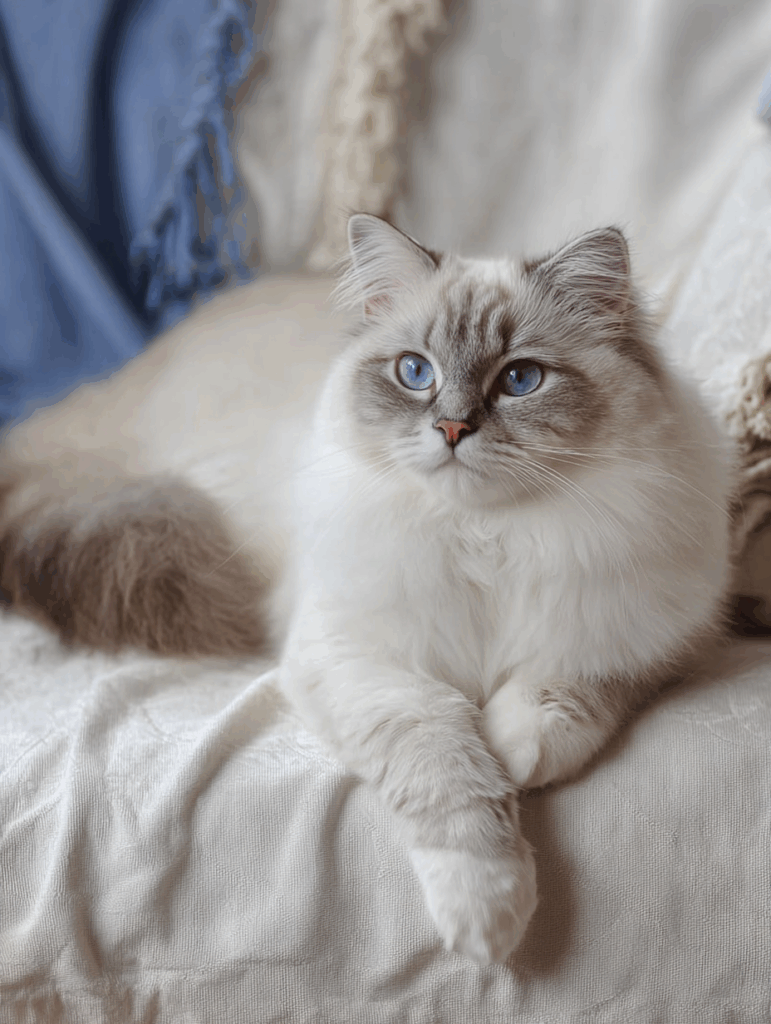
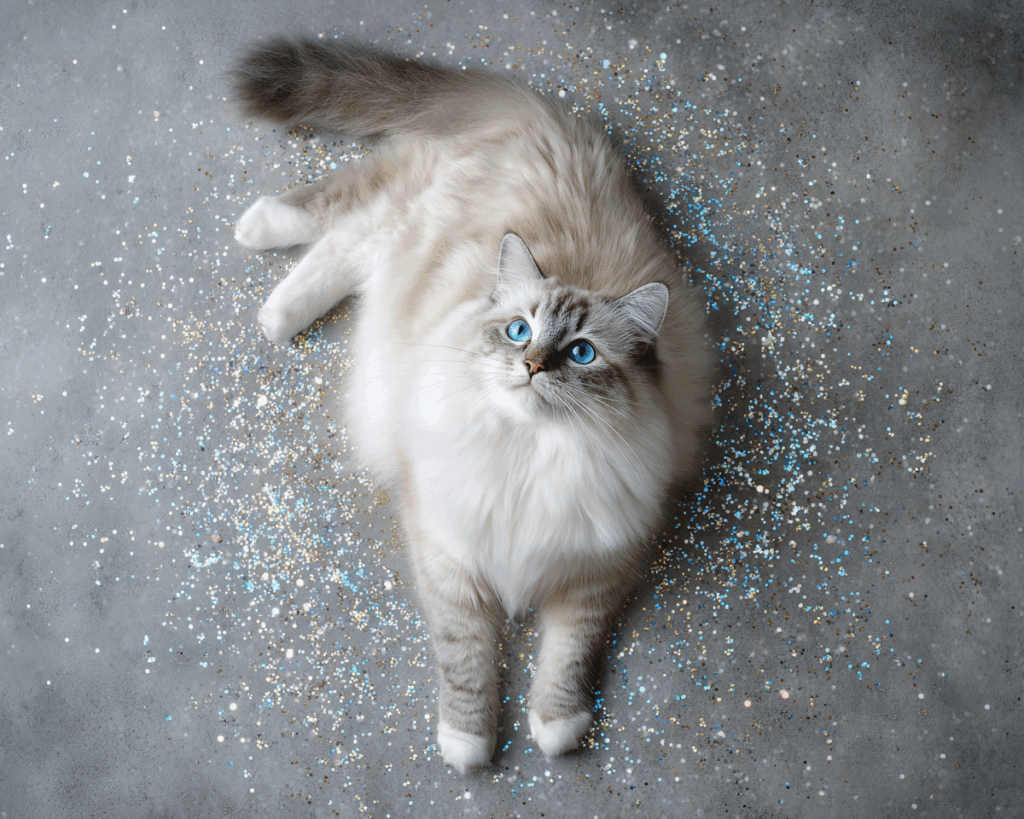

Frequently Asked Questions
What is the difference between a Lynx Ragdoll and a regular Ragdoll?
The lynx has tabby striping while a regular Ragdoll has solid-colored points. The lynx pattern does not affect the breed’s temperament.
Are Lynx Ragdolls purebred?
Yes. The lynx pattern is part of the Ragdoll breed standard and recognized by TICA and CFA.
How much does a Lynx Ragdoll cost?
Prices vary by color, pedigree, and breeder reputation. On average, a pet-quality Lynx Ragdoll ranges from $2,500 to $4,500. Read our full Ragdoll Kitten Pricing for more details.
Do Lynx Ragdolls shed a lot?
They shed moderately, usually less than Persians or Maine Coons. Regular brushing helps manage loose fur.
Final Thoughts
The Lynx Ragdoll cat is a captivating blend of the traditional Ragdoll’s gentle nature and the wild beauty of tabby markings. Whether in seal lynx, blue lynx, or bicolor, these cats bring both elegance and personality into the home.
If you are drawn to this pattern, explore our available kittens and learn how to reserve your own from trusted breeders on our Ragdoll Kittens for Sale page.
Related Reading
Lynx Color Variations:
- Seal Lynx Point Ragdoll
- Seal Lynx Mitted Ragdoll
- Blue Mitted Ragdoll
- Chocolate Lynx Point Ragdoll
- Lilac Lynx Point Ragdoll
Genetics & Pattern Guides:
Resources
- The International Cat Association (TICA) – Official Ragdoll Breed and Color Standards
https://tica.org/breed/ragdoll/ - Cat Fanciers’ Association (CFA) – Ragdoll Breed Standard
https://cfa.org/ragdoll/ - UC Davis Veterinary Genetics Laboratory – Feline Coat Color and Pattern Genetics
https://vgl.ucdavis.edu/ - International Cat Care – Cat Coat Colours and Patterns Explained
https://icatcare.org/cat-advice - University of Missouri Feline Genetics Laboratory (Leslie A. Lyons, Ph.D.) – Research on Cat Color and Pattern Genes
https://cvm.missouri.edu/research/feline-genetics-and-comparative-medicine-laboratory/ - Journal of Heredity – Studies on the Genetics of Cat Coat Color and Pattern
https://academic.oup.com/jhered - Basepaws Cat Genetics Library – Understanding Cat Coat Color Genetics
https://technomeow.com/basepaws-cat-dna-test-review/ - Messybeast Feline Genetics Resource – Ragdoll Gene Overview
http://messybeast.com/colourpoints-birman-ragdoll.htm - Ragdoll Fanciers Club International (RFCI) – Breed Education and Color Information
https://rfci.org/ - Cornell Feline Health Center – Coat Colors and Genetics Overview
https://www.vet.cornell.edu/departments-centers-and-institutes/cornell-feline-health-center
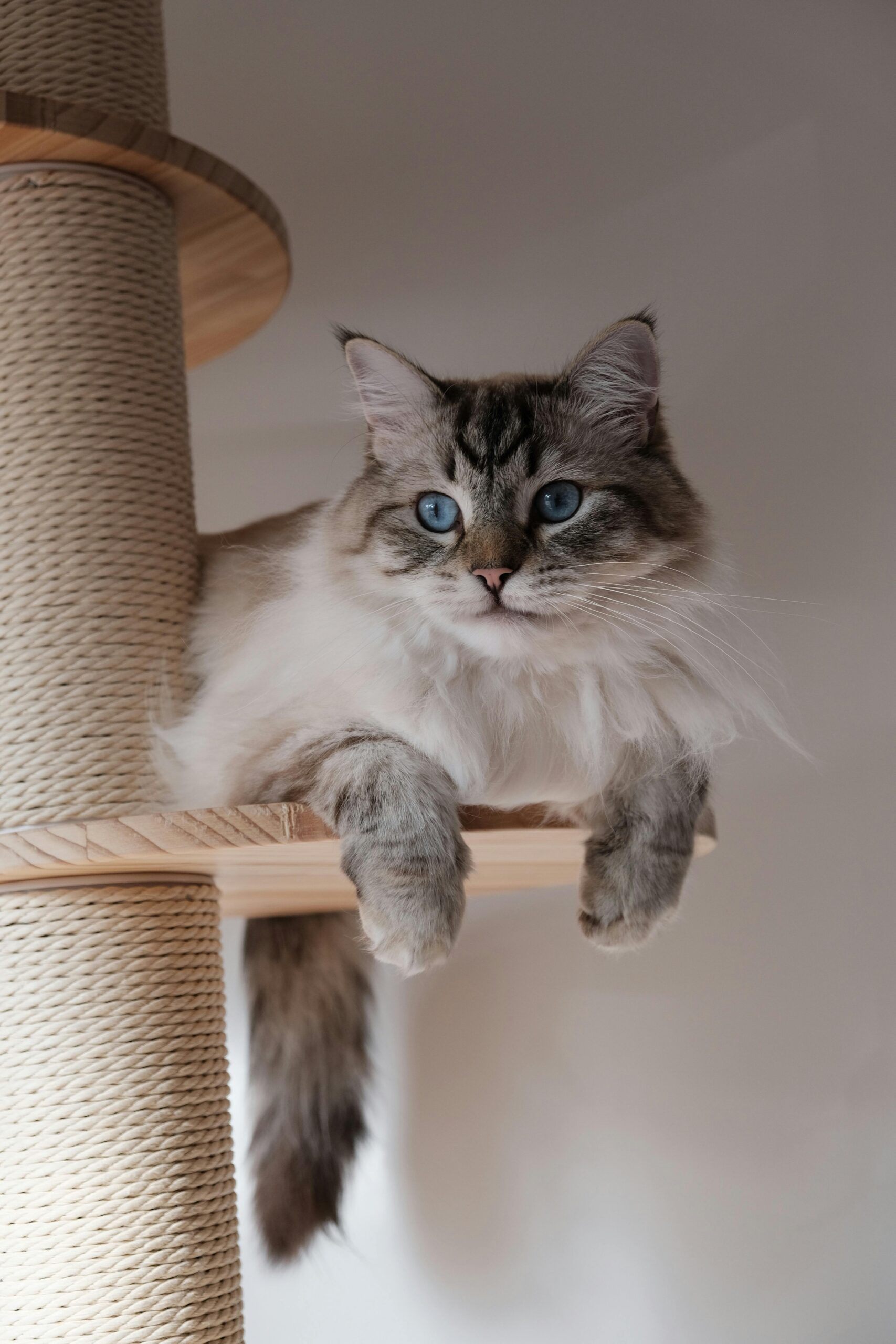
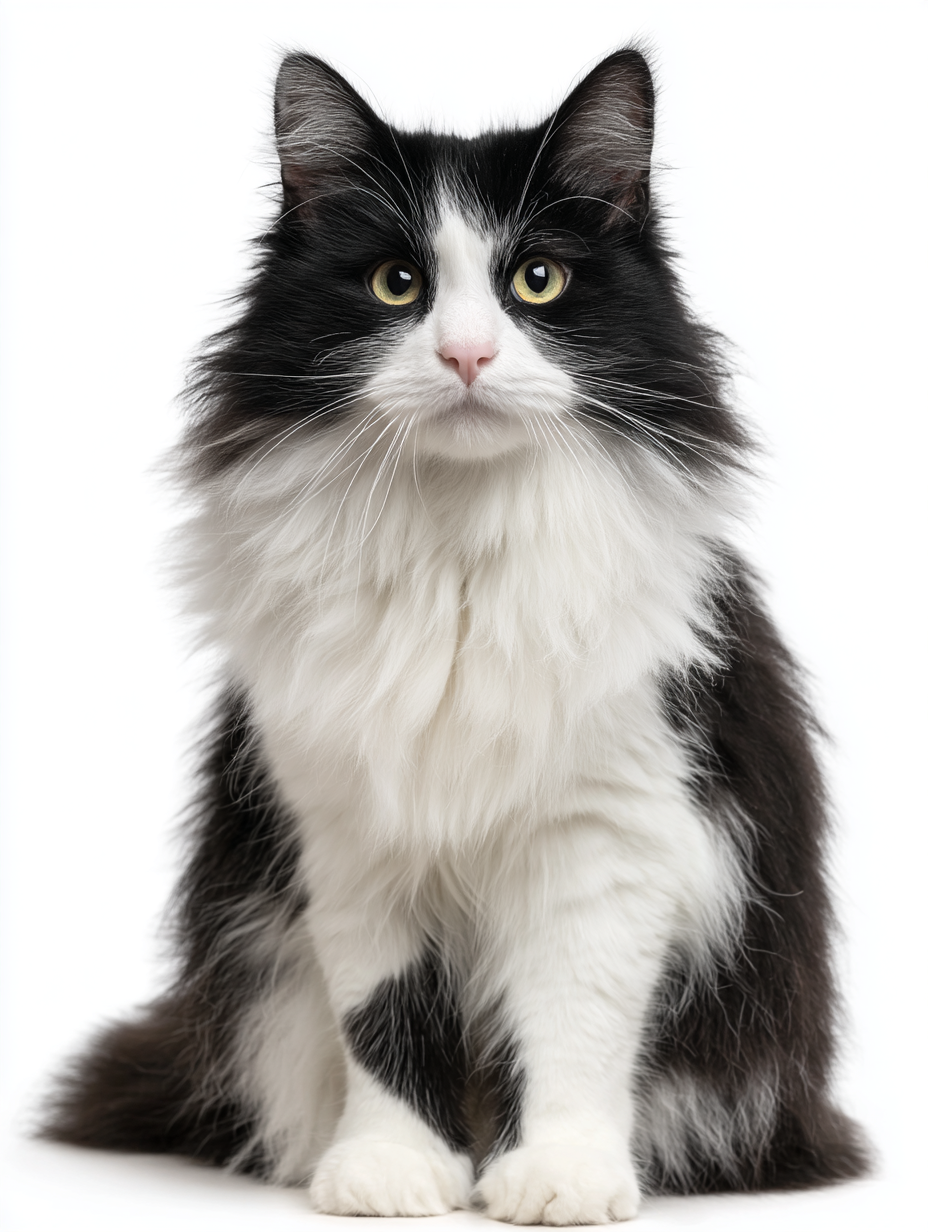
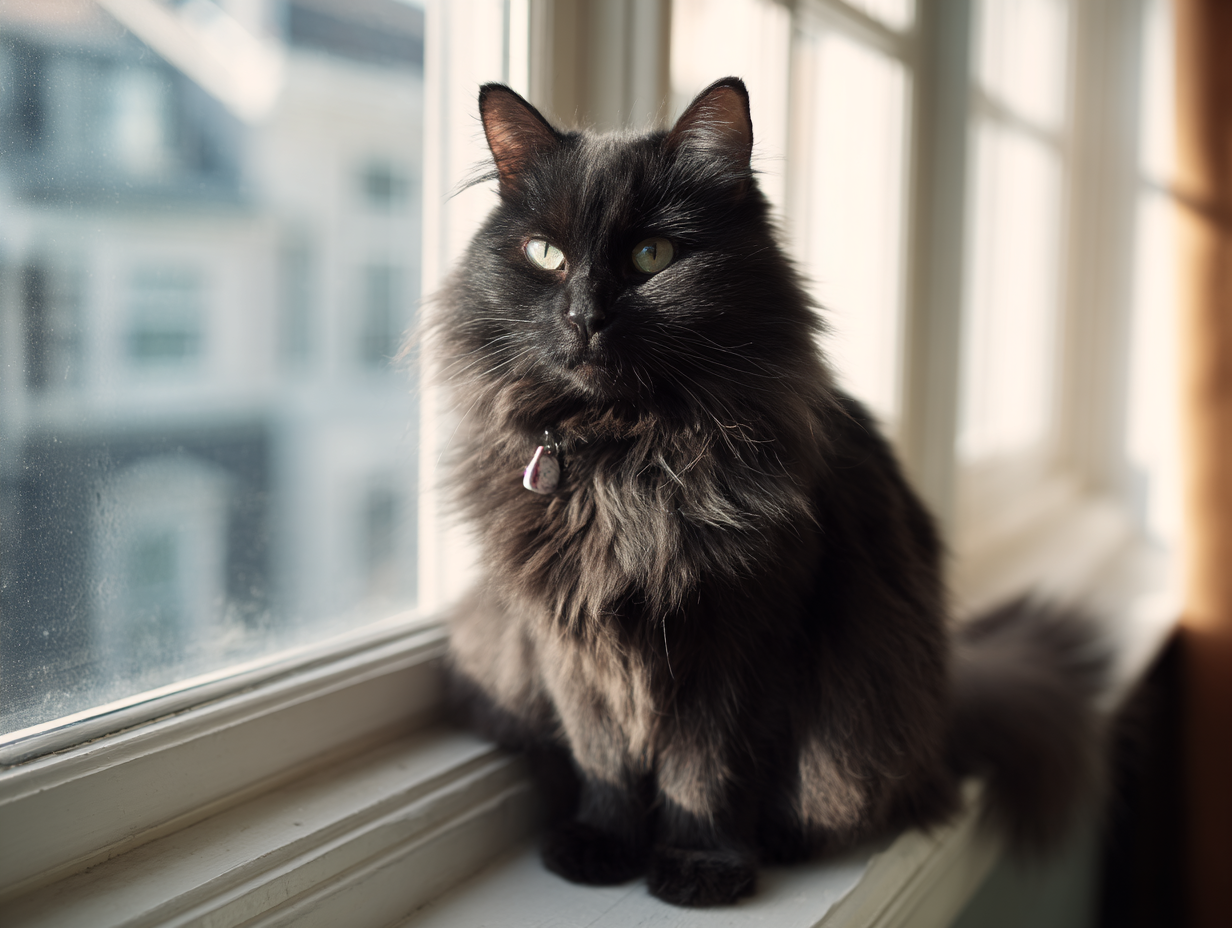
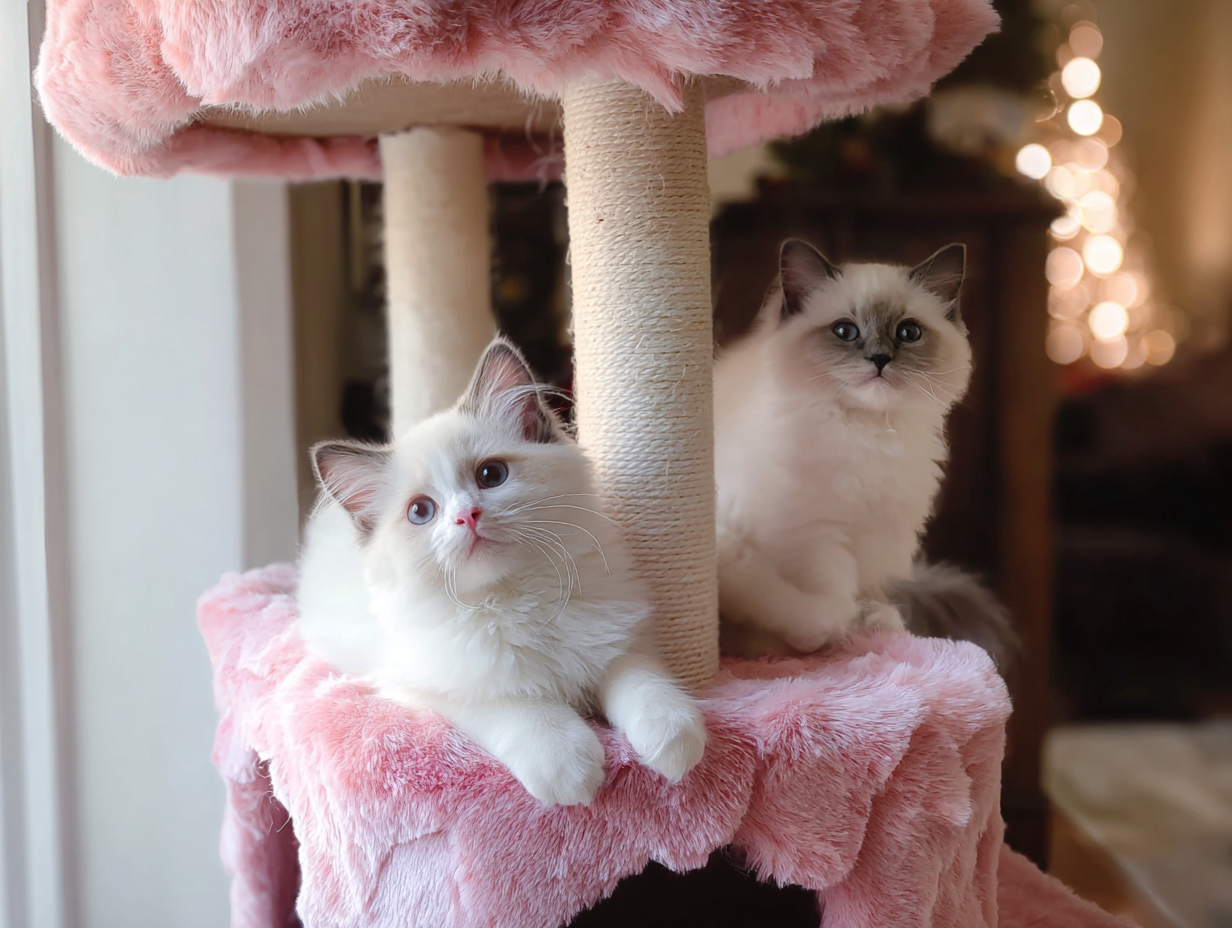
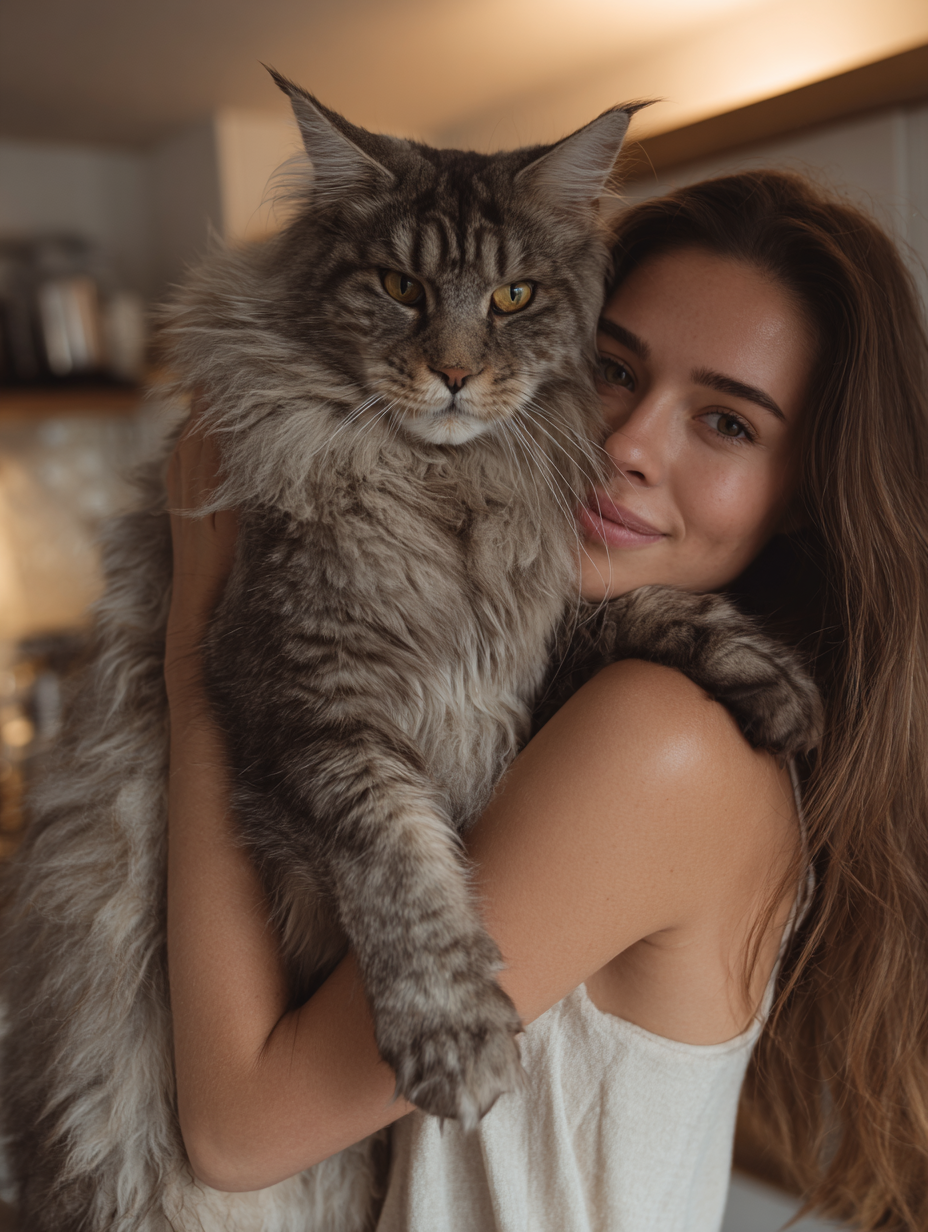

Read the Comments +